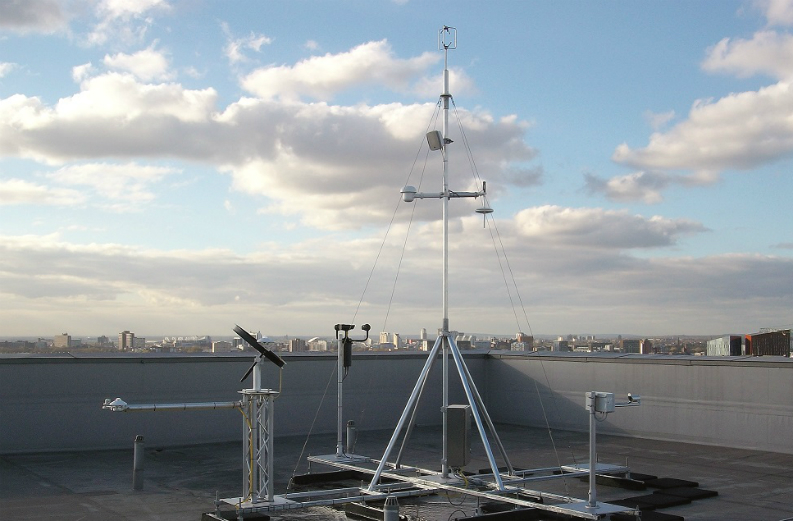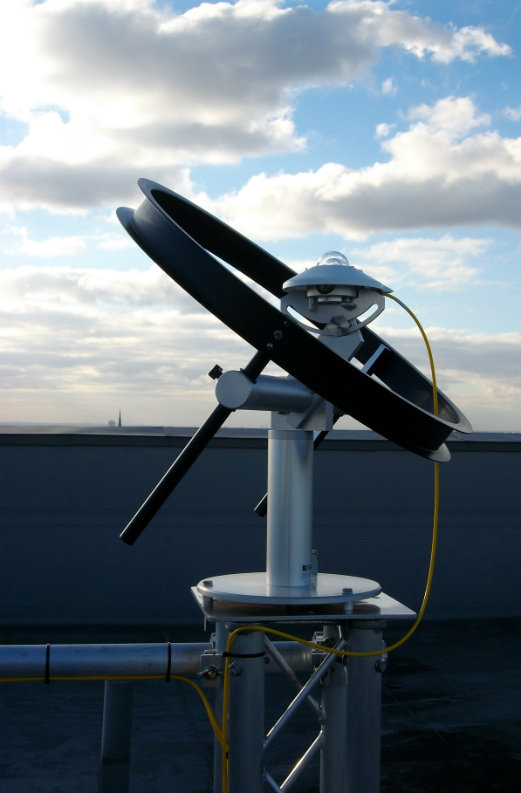 The new observatory on the university roof in Manchester
The new observatory on the university roof in Manchester
Measurements of standard meteorological parameters including wind, temperature and humidity, solar radiation, pressure, precipitation, cloud height and visibility are made continuously with data being made available publicly in real time via the internet.
The current observatory was established in 2010 and is a replacement for the original observatory that was set up and located in Whitworth Park in August 1892. Funding for this new observatory came from the legacy of Sir Joseph Whitworth, which established and maintained the original observatory as a source of data for scientific, education and popular interest until its demise in 1958.
A Little History
In 1893 the Residuary Legatees of the late Sir Joseph Whitworth, the Manchester Whitworth Institute and the Owens College (which later became The Victoria University of Manchester which merged with UMIST in 2004 to create The University of Manchester) provided through endowment an agreement for the maintenance of the ‘Meteorological Observatory in Whitworth Park’ which had been in operation since August 1892.
This observatory was to serve as a source of scientific and popular interest and of education. Data from the Whitworth Observatory were provided by the University to the Guardian newspaper for daily and weekly weather reports for the benefit of Manchester citizens. They were also forwarded to the Met Office. Unfortunately the observatory subsequently fell into disrepair due to repeated and extensive vandalism in the park location where it was situated and eventually burned down in 1958.
At that time the Victoria University of Manchester, which had taken over the endowment, decided to capitalize the funds until the future of the observatory could be decided. It was agreed in 2003 that the shares in the fund and the unspent balance should be transferred to the School of Earth, Atmospheric & Environmental Science since we ‘do work relevant to the purposes listed in the original 1893 Agreement.’
The increase in urbanization, and concerns with the climatic and health impacts of pollution from the urban environment have highlighted the need for high quality meteorological information in urban areas. In 2009 it was felt to be an opportune moment to re-visit the original legacy and its aims, thus a new observatory was constructed to provide data both for scientific research within growing cities on urban environment and climate issues, as well as for dissemination to the general public.
Location
Rather than place the new observatory in a park, or elsewhere at street level, a rooftop location was chosen. While this was partly because of security concerns, the rooftop location means that the measurements are not overshadowed by surrounding buildings or otherwise influenced by local effects of the city landscape. The observatory is located on the roof of the George Kenyon Building on the University of Manchester South Campus (N 53.467374, W 2.232006, Alt 43 m). At a height of 49 m the George Kenyon Building is the tallest building in the immediate vicinity.
Equipment
When designing the new observatory it was decided to use the most modern and best quality instrumentation that was available within the budget for the project. These instruments include an ultrasonic anemometer for wind measurements, laser disdrometer for precipitation measurements, laser ceilometer for cloud height measurements and digital sensors for temperature humidity and pressure. A full list of the instruments used and their specifications can be found on the observatory website.
Of particular interest for this article are the solar radiation instruments supplied by Kipp & Zonen. A pair of Kipp & Zonen CMP11 pyranometers was installed, one of them fitted with a Kipp & Zonen CM121B shadow ring. This configuration allows measurement of both global and indirect (diffuse) solar radiation from which direct solar radiation and sunshine hours can be calculated.
While it would have been preferable to install a solar tracker to make the direct and indirect solar radiation measurements, this was not possible within the budget available and the shadow ring was chosen as the next best option. While this does need regular adjustment (we have found weekly adjustments to be adequate) the adjustments are simple and no other maintenance has been required.
Usage
Data from the observatory has been used in support of scientific research projects focusing on urban climatology and air quality. It has also been extensively used to support projects by undergraduate and postgraduate research students from across the university and for a variety of purposes.
The plots of solar radiation data from the Whitworth Observatory show the contrast between a typically overcast Manchester day on 20th March 2015 and full sunshine on 4th June 2013. The effect of the recent solar eclipse is clearly visible on the plot from 20th March, being responsible for the significant dip in radiation between 9 am and 10 am.

The solar radiation data has regularly been used in student projects to assess the potential for electricity generation from photovoltaics. It has also been used by a large commercial provider of domestic solar panels to assess the operational efficiency of their installations.
Visit www.cas.manchester.ac.uk/restools/whitworth for more information about the observatory and to see real-time data
 Pyranometer and shadow ring
Pyranometer and shadow ring
Article by Dr. Michael Flynn, Centre for Atmospheric Science, School of Earth, Atmospheric and Environmental